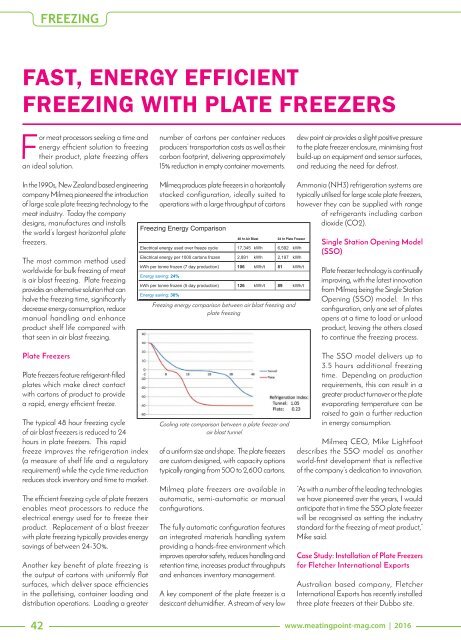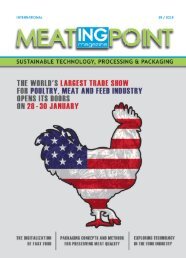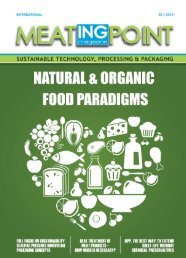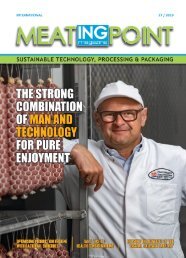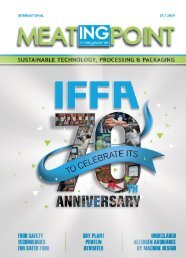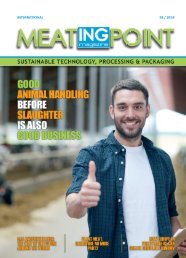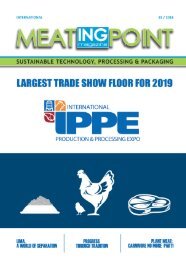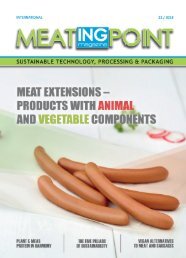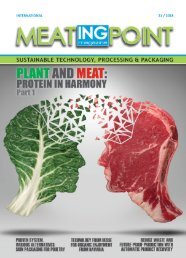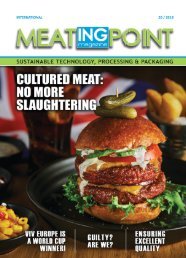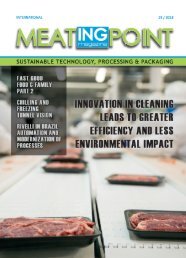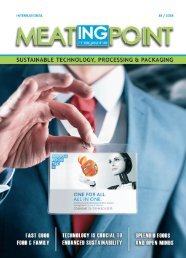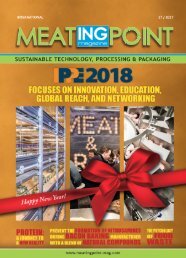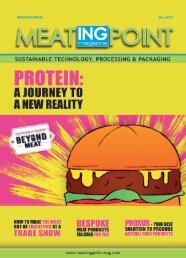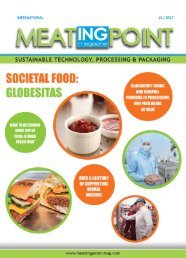MEATing POINT Magazine: #08/ 2016
You also want an ePaper? Increase the reach of your titles
YUMPU automatically turns print PDFs into web optimized ePapers that Google loves.
FREEZING<br />
Fast, Energy Efficient<br />
Freezing with Plate Freezers<br />
For meat processors seeking a time and<br />
energy efficient solution to freezing<br />
their product, plate freezing offers<br />
an ideal solution.<br />
number of cartons per container reduces<br />
producers’ transportation costs as well as their<br />
carbon footprint, delivering approximately<br />
15% reduction in empty container movements.<br />
dew point air provides a slight positive pressure<br />
to the plate freezer enclosure, minimising frost<br />
build-up on equipment and sensor surfaces,<br />
and reducing the need for defrost.<br />
In the 1990s, New Zealand based engineering<br />
company Milmeq pioneered the introduction<br />
of large scale plate freezing technology to the<br />
meat industry. Today the company<br />
designs, manufactures and installs<br />
the world’s largest horizontal plate<br />
freezers.<br />
The most common method used<br />
worldwide for bulk freezing of meat<br />
is air blast freezing. Plate freezing<br />
provides an alternative solution that can<br />
halve the freezing time, significantly<br />
decrease energy consumption, reduce<br />
manual handling and enhance<br />
product shelf life compared with<br />
that seen in air blast freezing.<br />
Milmeq produces plate freezers in a horizontally<br />
stacked configuration, ideally suited to<br />
operations with a large throughput of cartons<br />
Freezing Energy Comparison<br />
Electrical energy used over freeze cycle 17,345 kWh 6,592 kWh<br />
Electrical energy per 1000 cartons frozen 2,891 kWh 2,197 kWh<br />
kWh per tonne frozen (7 day production) 106 kWh/t 81 kWh/t<br />
Energy saving: 24%<br />
kWh per tonne frozen (5 day production) 126 kWh/t 89 kWh/t<br />
Energy saving: 30%<br />
48 hr Air Blast 24 hr Plate Freezer<br />
Freezing energy comparison between air blast freezing and<br />
plate freezing<br />
Ammonia (NH3) refrigeration systems are<br />
typically utilised for large scale plate freezers,<br />
however they can be supplied with range<br />
of refrigerants including carbon<br />
dioxide (CO2).<br />
Single Station Opening Model<br />
(SSO)<br />
Plate freezer technology is continually<br />
improving, with the latest innovation<br />
from Milmeq being the Single Station<br />
Opening (SSO) model. In this<br />
configuration, only one set of plates<br />
opens at a time to load or unload<br />
product, leaving the others closed<br />
to continue the freezing process.<br />
Plate Freezers<br />
Plate freezers feature refrigerant-filled<br />
plates which make direct contact<br />
with cartons of product to provide<br />
a rapid, energy efficient freeze.<br />
The typical 48 hour freezing cycle<br />
of air blast freezers is reduced to 24<br />
hours in plate freezers. This rapid<br />
freeze improves the refrigeration index<br />
(a measure of shelf life and a regulatory<br />
requirement) while the cycle time reduction<br />
reduces stock inventory and time to market.<br />
The efficient freezing cycle of plate freezers<br />
enables meat processors to reduce the<br />
electrical energy used for to freeze their<br />
product. Replacement of a blast freezer<br />
with plate freezing typically provides energy<br />
savings of between 24-30%.<br />
Another key benefit of plate freezing is<br />
the output of cartons with uniformly flat<br />
surfaces, which deliver space efficiencies<br />
in the palletising, container loading and<br />
distribution operations. Loading a greater<br />
Cooling rate comparison between a plate freezer and<br />
air blast tunnel<br />
of a uniform size and shape. The plate freezers<br />
are custom designed, with capacity options<br />
typically ranging from 500 to 2,600 cartons.<br />
Milmeq plate freezers are available in<br />
automatic, semi-automatic or manual<br />
configurations.<br />
The fully automatic configuration features<br />
an integrated materials handling system<br />
providing a hands-free environment which<br />
improves operator safety, reduces handling and<br />
retention time, increases product throughputs<br />
and enhances inventory management.<br />
A key component of the plate freezer is a<br />
desiccant dehumidifier. A stream of very low<br />
The SSO model delivers up to<br />
3.5 hours additional freezing<br />
time. Depending on production<br />
requirements, this can result in a<br />
greater product turnover or the plate<br />
evaporating temperature can be<br />
raised to gain a further reduction<br />
in energy consumption.<br />
Milmeq CEO, Mike Lightfoot<br />
describes the SSO model as another<br />
world-first development that is reflective<br />
of the company’s dedication to innovation.<br />
“As with a number of the leading technologies<br />
we have pioneered over the years, I would<br />
anticipate that in time the SSO plate freezer<br />
will be recognised as setting the industry<br />
standard for the freezing of meat product,”<br />
Mike said.<br />
Case Study: Installation of Plate Freezers<br />
for Fletcher International Exports<br />
Australian based company, Fletcher<br />
International Exports has recently installed<br />
three plate freezers at their Dubbo site.<br />
42 www.meatingpoint-mag.com | <strong>2016</strong>


